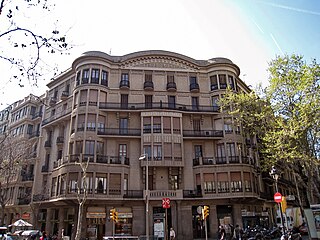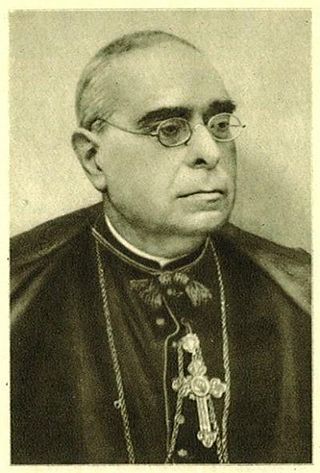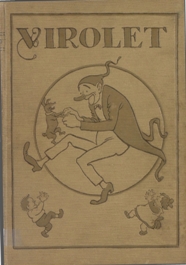
Jacint Verdaguer i Santaló was a Catalan writer, regarded as one of the greatest poets of Catalan literature and a prominent literary figure of the Renaixença, a cultural revival movement of the late Romantic era. The bishop Josep Torras i Bages, one of the main figures of Catalan nationalism, called him the "Prince of Catalan poets". He was also known as mossèn (Father) Cinto Verdaguer, because of his career as a priest, and informally also simply "mossèn Cinto".

Catalan cuisine is the cuisine from Catalonia. It may also refer to the shared cuisine of Northern Catalonia and Andorra, the second of which has a similar cuisine to that of the neighbouring Alt Urgell and Cerdanya comarques and which is often referred to as "Catalan mountain cuisine". It is considered a part of western Mediterranean cuisine.
Josefina Tanganelli Plana was a Catalan cartoonist and painter.

Noucentisme was a Catalan cultural movement of the early 20th century that originated largely as a reaction against Modernisme, both in art and ideology, and was, simultaneously, a perception of art almost opposite to that of avantgardists. In 1906, Eugeni d'Ors coined the term following the Italian tradition of naming styles after the centuries and using the homonyms nou (nine) and nou (new) to suggest it was a renovation movement. The same year two essential works for Noucentisme were published: Els fruits saborosos by Josep Carner and "La nacionalitat catalana" by the Conservative politician Enric Prat de la Riba.
Josep Abril i Virgili (1869-1918) was a self-taught Catalan poet and playwright. He specialized in the production of works with easily understood and popular moral lessons, which were publicised through Roman Catholic organizations.

The national symbols of Catalonia are flags, icons or cultural expressions that are emblematic, representative or otherwise characteristic of Catalonia or Catalan culture.

Josep Torras i Bages, born at Les Cabanyes, Alt Penedès, on 12 September 1846, died at Vic, Osona, on 7 February 1916, was a Catalan thinker, writer, and bishop. He was one of the main figures in the turn of the 20th century Catholic Catalan nationalism.

L'Esquirol known as Santa Maria de Corcó until 4 June 2014, is a municipality in the comarca of Osona in Catalonia, Spain.

Joan Junceda, full name Joan García Junceda i Supervia, was one of the most important Catalan artists and illustrators in the first half of the 20th century. His father was from Asturian origin. Junceda worked in many publications, including ¡Cu-Cut!, Papitu, Picarol and En Patufet.

¡Cu-cut! was a Catalan illustrated satirical magazine, written in Catalan. Published in Barcelona between 1902 and 1912, it followed the political line marked by Francesc Cambó's Lliga Regionalista.

Virolet was a children's weekly magazine that was first published in January 1922 as a supplement of the magazine En Patufet. The main writer and the administrator of the magazine was Cardenal Casañas. It was edited by the same editing company as En Patufet, the book shop Josep Bagunyà. Regarding the format of the magazine, the number had 8 pages with a measurement of 300x210 mm. it was printed in the house E. I J. Solà based in Valencia Street 200 in Barcelona. Nonetheless, from the year 1924, it started being printed in a printing house from Josep Bagunyà in the Muntaner Street. The subscription cost 5,50 pesetas and one number cost 0,10 pesetas.

The Flemish clock, or big clock of Barcelona, was the main clock of Barcelona for 287 years from 1577 to 1864. It was the 5th of the mechanical big clocks series that Barcelona had since 1396. In 1864 it was replaced by the 6th clock, a new one built by Albert Billeter, a Swiss watchmaker, because of the Hour's Local Service creation.

The National Front of Catalonia was a Catalan nationalist party which was active between 1940 and 1990. The FNC was created in 1940 by former members of the Estat Català and the Catalan Nationalist Party, with the latter dissolving and splitting its membership between the Estat Català and the FNC. The main goals of the FNC were to present an opposing front to the Spanish State of caudillo Franco and to advocate for Catalan independence. In 1946, the FNC became an officially independent party by breaking its relationship with the Estat Català.
Jaume Medina i Casanovas was a Catalan philologist, latinist, writer, translator and poet.

The Catalan Republic was a state proclaimed in 1931 by Francesc Macià as the "Catalan Republic within the Iberian Federation", in the context of the proclamation of the Second Spanish Republic. It was proclaimed on 14 April 1931, and superseded three days later, on 17 April, by the Generalitat de Catalunya, the Catalan institution of self-government within the Spanish Republic.

La Veu de Catalunya was a Catalan newspaper founded by Enric Prat de la Riba that was published in Barcelona from 1 January 1899 to 8 January 1937, with two editions daily.

Destino was a Spanish weekly magazine published in Spain between 1937 and 1980, initially in Burgos and from 1939 in Barcelona.
The ¡Cu-Cut! incident, also known as La Cuartelada, was an assault conducted by Spanish officers on the Catalan satirical magazine ¡Cu-Cut! offices in Barcelona on 25 November 1905 in response to the publication of a satirical cartoon mocking the Spanish military.
Jaume Clotet i Planas is a Catalan journalist, historian and writer.
















